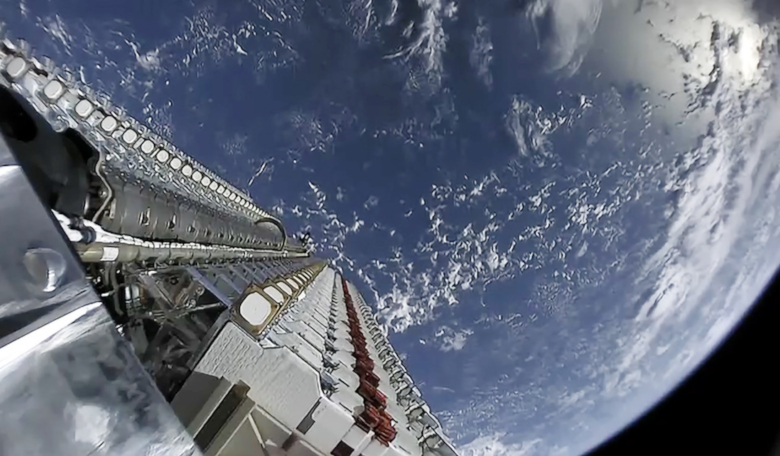Just as SpaceX gets ready to launch a further 60 satellites today as part of its Starlink mega constellation, the company is seeking regulatory approval from the US Federal Communications Commission (FCC) for permission to operate all 4,400 of its first-generation satellites at much lower altitudes than previously planned.
In its application to the FCC on Friday (17th April) Elon Musk’s SpaceX firm has requested to relocate the remaining 2824 of the 4,400 Starlink network previously authorised to operate at altitudes from 1,110 kilometres (km) to 1,325 kilometres “down to altitudes ranging from 540 km to 570 km, and to make related changes.” So far 362 satellites of Musk's planned mega-constellation have been deployed.
In the documentation submitted in support of the application, SpaceX has stipulated safety measures and increased broadband coverage as the reasons for adjusting the satellites altitude.
“Because of the increased atmospheric drag at this lower altitude, this relocation will significantly enhance space safety by ensuring that any orbital debris will quickly re-enter and demise in the atmosphere. And because of its closer proximity to consumers on Earth, this modification will allow SpaceX’s system to provide low-latency broadband to unserved and underserved Americans that is on par with service previously only available in urban areas,” says the report submitted to the FCC.
This move follows similar requests previously issued to the FCC by the company to lower the altitudes of its Starlink satellite network.
Prior to the launch of its first 60 Starlink satellites in May last year, the Commission granted SpaceX’s first modification request by authorising the reposition of the fleet’s first 1,584 satellites from 1,150 kilometres to 550 kilometres above Earth in planes inclined 53 degrees to the equator.
This “modest adjustment” states SpaceX in the their current FCC application, allowed the company to broaden its geographic reach in the early stages of the constellation’s deployment. An advantage the billionaire entrepreneur wants the remainder of his Ku- and Ka- band satellites to benefit from.
SpaceX have also acknowledged in their application, concerns raised by a number of parties regarding the problems vast quantities of satellites in a low-Earth orbit could cause.
Some small satellite operators have in the past said it would make it more difficult for them to deploy their own non-propulsive systems near SpaceX’s orbits.
SpaceX played down the response by saying it has “repeatedly made clear” that it intends to help mitigate any potential problem by conducting active manoeuvres to avoid collisions with both other spacecraft and debris throughout the life of its satellites.
This, however, should be a two-way process as the firm “also expects other systems to take reasonable steps to avoid collision as well,” state SpaceX in their application.
The company has said it will assist with this measure by providing all of its ephemeris data to other operators via spacetrack.org, so that other operators can better predict the trajectories of its satellites.
Concerns raised by the astronomical community in regards to reflected light from the satellites, in particular those using optical telescopes, also got a mention in the application.
In a similar move, SpaceX has said it will make satellite tracking data available so astronomers can better coordinate their observations with Starlink satellites.
Having experimented with a darkening treatment on one satellite in its third Starlink launch back in January, to further reduce the albedo of its body, the company said it is developing new mitigation efforts that it plans to test in the coming months.
Sticking with their original deployment strategy by keeping satellites in higher orbits will not combat the problem though say SpaceX.
“Despite some claims to the press, operating at higher orbits does not alleviate the need for operators to take additional steps to mitigate their impact on optical astronomy—in fact, higher orbits may worsen the effect in some cases. SpaceX therefore encourages other satellite operators to engage in similar active steps to study their effects on astronomy,” specify SpaceX in their FCC application.
But, whether you love them or hate them, spotting Starlink constellation trains in the night skies, seems to have now become a popular activity for some.
One upon a time it was the thought of seeing a fireball zipping through the atmosphere as a meteor shower passed overhead, that drew people out into the night to stare up into space. Now, armed with knowledge of what time a mega-constellation will pass overhead, people are now flocking to their gardens to go satellite spotting and posting any captured images of the Starlink trains to Twitter under the #Starlink or #Starlink hashtags.
SpaceX is targeting today (22 April, 2020) at 3:37 pm EDT, or 19:37 pm GMT, for its seventh launch of Starlink satellites. Falcon 9 will lift off from Launch Complex 39A (LC-39A) at NASA’s Kennedy Space Center in Florida. A backup opportunity is available on Thursday, April 23 at 3:15 pm EDT, or 19:15 GMT.











